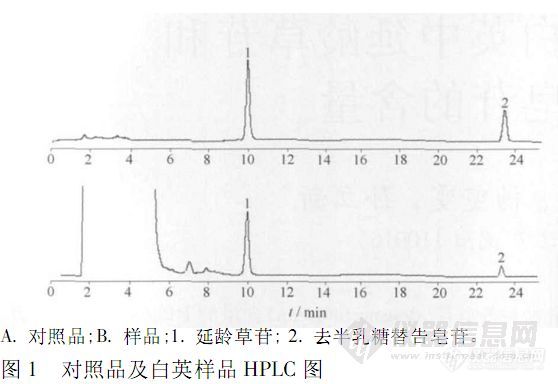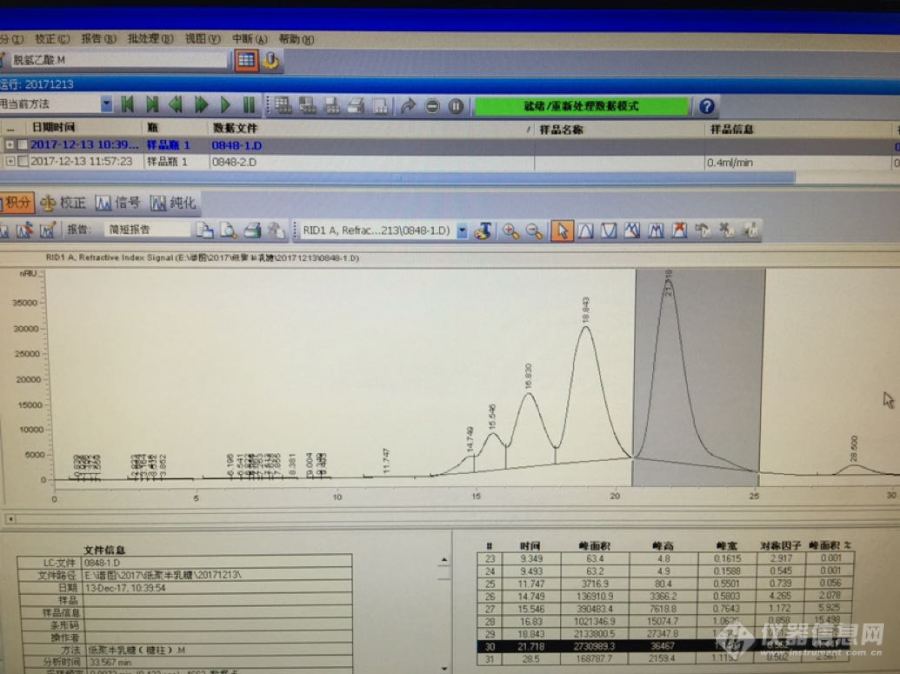
根据《中华人民共和国食品安全法》和《食品添加剂新品种管理办法》,经审核,现批准β-半乳糖苷酶为食品添加剂新品种;6-甲基辛醛为食品用香料新品种;氧化亚氮、阿拉伯胶、红曲黄色素、抗坏血酸(维生素C)、迷迭香提取物、二甲基二碳酸盐(又名维果灵)、硫酸铝钾(又名钾明矾)/硫酸铝铵(又名铵明矾)、磷酸、焦磷酸钠、六偏磷酸钠、迷迭香提取物(超临界二氧化碳萃取法)等11种食品添加剂扩大使用范围、用量。 特此公告。 国家卫生计生委 2015年1月23日http://ng1.17img.cn/bbsfiles/images/2015/01/201501301539_533609_1060664_3.png
我用PA1的柱甘露糖先出峰,而资料上PA10,PA20 的柱都是半乳糖先出峰,是不是柱子的问题,淋洗液一样
请问各位大佬,用HPLC-CAD分析单糖时,葡萄糖和半乳糖,葡萄糖醛酸和半乳糖醛酸总是分不开,用的柱子是Xbridge BEH Amide(4.6*250mm ,3.5 um),请问有友友做过类似的或有好的建议吗
最近要做个载有半乳糖的平面膜片上生物素对其的识别。已经买了FITC标记的豌豆凝集素,可是只有10mg(还要2000rmb),然后打算让它与膜片上的糖基特异性结合后用共焦激光显微镜(CLSM)检测。不知道那个荧光素标记的凝集素要配成溶液还是怎样的,请教达人了。[em31]
最近想做一个方法测定阿拉伯糖、木糖、半乳糖。想请教各位高手如何测定阿拉伯糖、木糖、半乳糖的?在实际测定过程中有什么难点和注意点?谢谢!
有人做过低聚半乳糖的检测吗?稳定吗?

【作者】 贾玉荣; 孙长山; 孙艳秀; 杨雯雯; 孙立新;【Author】 JIA Yurong,SUN Changshan,SUN Yanxiu,YANG Wenwen,SUN Lixin(College of Pharmacy,Shenyang Pharmaceutical University,Shenyang 110016)【机构】 沈阳药科大学药学院;【摘要】 目的:建立同时测定白英中延龄草苷(trillin)和去半乳糖替告皂苷(desgalactotigonin)含量的HPLC-ELSD法。方法:采用Diamonsil-C18色谱柱(4.6 mm×250 mm,5μm),流动相乙腈-10 mmol.L-1醋酸铵溶液52∶48,柱温25℃,流速0.6mL.min-1,进样量20μL,检测器漂移管温度为95℃,氮气流速2.3 L.min-1。结果:延龄草苷和去半乳糖替告皂苷分别在20~200 mg.L-1(r=0.999 8)和10~100 mg.L-1(r=0.999 7)内线性关系良好。延龄草苷的平均回收率为99.4%,RSD为0.90%;去半乳糖替告皂苷的平均回收率为100.3%,RSD 1.1%。结论:该方法准确,重复性良好,适用于白英药材的质量控制。 更多还原http://ng1.17img.cn/bbsfiles/images/2012/08/201208131312_383451_2379123_3.jpg
三糖铁琼脂培养基( l )成分 蛋白胨 20g 硫酸亚铁 0.2g 牛肉浸出粉 5g 硫代硫酸钠 0.2g 乳糖 10g 002%酚磺酞指示液 12.5ml 蔗糖 10g 琼脂 12~15g 葡萄糖 1g 水 1000ml 氯化钠 5g ( 2 )制法 除乳糖、蔗糖、葡萄糖、指示液、琼脂外,取上述成分,混合,加热使溶解,调pH 值使灭菌后为7.3 士0.1 ,加入琼脂,加热溶胀后,再加入其余成分,摇匀,分装,121 ℃ 灭菌15 分钟,制成高底层(2 ~3cm ) 短斜面。( 3 )用途 用于初步鉴别肠杆菌科细菌对糖类的发酵反应和产生硫化氢试验。 方法和结果观察:取可疑菌落或斜面培养物,做高层穿刺和斜面划线接种,置35 ℃ 培养24~ 48 小时,观察结果。培养基底层变黄色为葡萄糖发酵阳性,斜面层变黄色为乳糖、蔗糖发酵阳性;底层或整个培养基呈黑色表示产生硫化氢。
哪位做过半乳糖醛酸方面的分析[em16]
本人最近在做糖方法分析时遇到一些困惑,求助各位高手赐教阿所用仪器为Agilent1290液相色谱,蒸发光散色检测器,prevail carbohydrate ES 5u 4.6mm*250mm,流动相为乙腈和水,调适了流动相各种比例,始终无法很好分离甘露糖、半乳糖、葡萄糖,不知你们做的时候能有多少分离度?
1.原理分析 本培养基适合于肠杆菌科的鉴定。用于观察细菌对糖的利用和硫化氢(变黑)的产生。 该培养基含有乳糖、蔗糖和葡萄糖的比例为10:10:1,只能利用葡萄糖的细菌,葡萄糖被分解产酸可使斜面先变黄,但因量少,生成的少量酸,因接触空气而氧化,加之细菌利用培养基中含氮物质,生成碱性产物,故使斜面后来又变红,底部由于是在厌氧状态下,酸类不被氧化,所以仍保持黄色。而发酵乳糖的细菌(e.coli),则产生大量的酸,使整个培养基呈现黄色。如培养基接种后产生黑色沉淀,是因为某些细菌能分解含硫氨基酸,生成硫化氢,硫化氢和培养基中的铁盐反应,生成黑色的硫化亚铁沉淀。2.试验方法 以接种针挑取待试菌可疑菌落或者纯造就物穿刺接种并涂布于斜面置36±1℃造就18-24h观察结果3.化学性质 粉红色粉末,一种鉴别培养基,由牛肉膏、酵母菌膏、卵白胨、 胨、葡萄糖、乳糖、蔗糖、硫酸亚铁、氯化钠、硫代硫酸钠、酚红、琼脂等配合制造而成。易吸湿,加水煮沸熔解后成橘红色半透明液体,pH约7.5,冷至45℃开始凝固。
我要分离葡萄糖,木糖,阿拉伯糖和半乳糖,我查了一下,说可以用季胺盐硼酸型阴离子树脂来分离,可是那树脂买不到阿。郁闷中。请各位高手帮帮忙,帮我支个招,小妹在此不胜感激阿。
我用的是氨基柱,安捷伦LC1200,示差折光检测器,请问各位前辈用什么流动相条件可以分离葡萄糖和半乳糖??
如题用液质的方法检测尿液中的氨基葡萄糖,但是会不会有异构体氨基半乳糖干扰测定?如果不会,如何证明?请教高手!
[size=4][font=Times New Roman]1 [/font][/size][size=4][font=宋体]乳糖的化学变化[/font][/size][size=4][/size][size=4][font=Times New Roman]1.1[/font][/size][size=4][font=宋体]水解[/font][/size][size=4][/size][size=4][font=Times New Roman]1.1.1 [/font][/size][size=4][font=宋体]乳糖在稀酸条件下加热,则分解成葡萄糖和半乳糖。[/font][/size][size=4][/size][size=4][font=Times New Roman]1.1.2 [/font][/size][size=4][font=宋体]乳糖可以被[/font][/size][size=4][font=Times New Roman]B-D-[/font][/size][size=4][font=宋体]半乳糖苷酶水解为半乳糖和葡萄糖,副反应可生成多种寡糖类。[/font][/size][size=4][/size][size=4][font=Times New Roman][/font][/size][size=4][font=宋体]乳糖在低浓度时生成的寡糖类是微量的,而高浓度时会生成相当量的寡糖类。多低?多高?[/font][/size][size=4][/size][size=4][font=Times New Roman]1.2[/font][/size][size=4][font=宋体]乳糖的异构反应[/font][/size][size=4][/size][size=4][font=Times New Roman] [/font][/size][size=4][font=宋体]乳糖在碱性溶液中,其中的葡萄糖分子将部分的异构化而生成异构乳糖,亦称为乳果糖或二蔗酮糖。[/font][/size][size=4][/size][size=4][font=Times New Roman] [/font][/size][size=4][font=宋体]乳果糖的熔点为[/font][/size][size=4][font=Times New Roman]158[/font][/size][size=4][font=宋体]摄氏度,[/font][/size][size=4][font=Times New Roman][a][sub]d[/sub][sup]20[/sup]=-51.5[sup]o[/sup],[/font][/size][size=4][font=宋体]是一种新型的功能性物质。由于异构乳糖能促进人体肠道内双歧杆菌的增殖,所以亦称为双歧增殖因子,广泛应用于多种乳制品或其他食品中。[/font][/size][size=4][/size][size=4][font=宋体]乳糖经高温加热可生成异构乳糖,半乳糖,塔格糖等糖类,还可生成甲酸,乳酸等有机酸。[/font][/size][size=4][/size][size=4][font=Times New Roman][/font][/size][size=4][font=宋体]乳糖是还原性双糖,其本身及分解产物与乳中的蛋白质会发生美拉德反应,是乳制品褐变的主要原因。[/font][/size][size=4][/size][size=4][font=Times New Roman]1.3[/font][/size][size=4][font=宋体]褐变反应[/font][/size][size=4][/size][size=4][font=宋体]牛乳经长时间高温加热则发生褐变反应。这类反应属于非酶褐变,主要是羰[/font][/size][size=4][font=Times New Roman]-[/font][/size][size=4][font=宋体]氨反应,其次是乳糖的焦糖化反应。[/font][/size][size=4][/size][size=4][font=Times New Roman][/font][/size][size=4][font=宋体]牛乳的羰[/font][/size][size=4][font=Times New Roman]-[/font][/size][size=4][font=宋体]氨反应即美拉德([/font][/size][size=4][font=Times New Roman]Maillard[/font][/size][size=4][font=宋体])反应,是酪蛋白的末端氨基酸[/font][/size][size=4][font=Times New Roman]-[/font][/size][size=4][font=宋体]赖氨酸的游离氨基与乳糖的羰基发生反应,最终生成褐色物质。[/font][/size][size=4][/size][size=4][font=宋体]当牛乳加热到[/font][/size][size=4][font=Times New Roman]100[/font][/size][size=4][font=宋体]摄氏度以上,例如在[/font][/size][size=4][font=Times New Roman]120[/font][/size][size=4][font=宋体]摄氏度,[/font][/size][size=4][font=Times New Roman]7.5[/font][/size][size=4][font=宋体]分钟时,容易发生美拉德反应。[/font][/size][size=4]待续%%%%%%%%%[/size]
版友问题:奶粉中低聚半乳糖目前有什么好的检测方法,谢谢
高效[url=https://insevent.instrument.com.cn/t/3p][color=#3333ff]离子色谱[/color][/url]法测定糖浆中低聚半乳糖含量
各位同行,大家好: 我是乳品企业的一名检测员,最近我们公司要检测一下乳糖,低聚果糖,低聚半乳糖等糖类,要用离子色谱法,我没有相关经验,恳请各位同行指教一下,如何选择离子色谱仪以及糖类离子色谱检测的相关知识。谢谢大家了。

高效液相色谱使用钙型离子交换柱测低聚半乳糖,流动相是超纯水,柱温80℃,流速0.4ml/min。峰分不开怎么办?[img=,690,516]http://ng1.17img.cn/bbsfiles/images/2017/12/201712131552_01_3330811_3.png[/img]
多聚半乳糖醛酸、多聚鼠李糖半乳糖醛酸、等果胶相关的大分子的HPLC检测方法和柱子的选择分别如何进行?我想根据不同的果胶酶分解果胶,然后用HPLC检测酶解产物分别是什么。有没有大侠帮忙解答一下!提供HPLC的方法和哪种柱子能够符合条件?凝胶柱是否能够跑出来?关于分析这块完全是新手,还请凡得知有关信息的朋友能够帮忙解答!Thank you!!!
沙门氏菌检验培养基和试剂 缓冲蛋白胨水(BPW ) 四硫磺酸钠煌绿(TTB )增菌液 亚硒酸盐胱氨酸(SC )增菌液 亚硫酸秘(Bs)琼脂 HE(Hoktoen Entoric)琼脂。 木糖赖氨酸脱氧胆盐(XLD)琼脂 沙门氏菌属显色培养基 三糖铁(TsI)琼脂 蛋白陈水、靛基质试剂 尿素琼脂(pH7.2 )。 氰化钾(KCN )培养基 赖氨酸脱羧酶试验培养基 糖发酵管 邻硝基酚份B-D半乳糖苷(ONPG)培养基 半固体琼脂 丙二酸钠培养基 沙门氏菌O和H 诊断血清。 API 20E 生化鉴定试剂盒或VITEK GN 生化鉴定卡
建立采用高效液相色谱-蒸发光散射检测(HPLC-ELSD)法同时测定大枣多糖酸性条件下水解产物中阿拉伯糖和D-半乳糖含量的方法。实验结果表明:制备的样品中阿拉伯糖和D-半乳糖分离良好,阿拉伯糖和D-半乳糖分别在2.00~10.00 μg(r2 = 0.9957)和2.08~10.40 μg(r2 = 0.9903)范围内呈良好的线性关系;平均加样回收率分别为103.87%(RSD = 5.42%,n = 9)和93.04%(RSD = 4.90%,n = 9)。该方法稳定性和重复性好,可为大枣质量评价和控制提供参考。
[color=#DC143C][size=4][font=黑体] 我是第一次做液相色谱,想问下大家,半乳糖醛酸的液相条件是什么? 我在一篇文献中查到,用紫外检测器 ,流动相是磷酸盐缓冲液,但我用后连标准品都没有峰,所以想询问下朋友们有没有知道原因出在哪个,或者推荐个其他的色谱条件! 很着急用,麻烦大家了,无比感谢!!![/font][/size][/color]
现在使用的PA20色谱柱比较矫情,我们检测量大,需要频繁更换,用一段时间就分离不好了,但是检测低聚果糖的PA1色谱柱就很稳定,之前检测低聚果糖也是用PA20的,后来换成PA1的。所以想问问大家能不能把检测低聚半乳糖PA20换成PA1呢?
[align=center][font='times new roman'][size=24px]2021.0[/size][/font][font='times new roman'][size=24px]7[/size][/font][font='times new roman'][size=24px].[/size][/font][font='times new roman'][size=24px]29[/size][/font][/align][align=center][/align][align=center][font='黑体'][size=20px]琼脂[/size][/font][/align][align=center][font='times new roman']陈珺宁[/font][/align][align=center][font='times new roman'](厦门大学化学化工学院)[/font][/align][font='times new roman']摘要:[/font][font='times new roman']琼脂是一种从某些海藻萃取的亲水胶体,在人们日常生产生活的各个领域中有广泛的应用。琼脂可以改善食品的质构,提升食品的品质,并且没有任何毒性,成为一种重要的食品添加剂,在食品工业中可以作为增稠剂、凝固剂、[/font][url=https://baike.baidu.com/item/%E6%82%AC%E6%B5%AE%E5%89%82][font='times new roman']悬浮剂[/font][/url][font='times new roman']、[/font][url=https://baike.baidu.com/item/%E4%B9%B3%E5%8C%96%E5%89%82][font='times new roman']乳化剂[/font][/url][font='times new roman']、保鲜剂和稳定剂等,被广泛应用。本文将对琼脂的理化性质、提取工艺与深加工、限量、标准、检测、应用等进行逐一介绍,有助于对该食品添加剂的了解。[/font][font='times new roman']关键词:[/font][font='times new roman']食品添加剂,琼脂,性质,提取,限量,[/font][font='times new roman']标准,检测,应用[/font][font='times new roman'][size=18px]0 [/size][/font][font='times new roman'][size=18px]引言[/size][/font][font='times new roman']琼脂([/font][font='times new roman']agar[/font][font='times new roman']),又称琼胶、洋菜、洋粉或冻粉等,根据中华人民共和国药典记载,琼脂系自石花莱[/font][font='times new roman']Gelidium amansii Lamx[/font][font='times new roman']或其他数种红藻类植物中浸出并经脱水干燥的粘[url=https://insevent.instrument.com.cn/t/Yp][color=#3333ff]液质[/color][/url];按照美国药典定义,琼脂是一种从[/font][font='times new roman']Rhodophyceae[/font][font='times new roman']类的某些海藻萃取的亲水胶体。琼脂由琼脂糖和琼脂胶组成,是一种由半乳糖和半乳糖衍生物构成的长链形多糖。其中,半乳糖残基上不含硫酸基、甲氧基、丙酮酸基等基团,可发生凝胶化的长链中性多糖是琼脂糖;半乳糖残基上含有这些基团,不发生凝胶化的长链酸性多糖是琼脂胶[/font][font='times new roman']。[/font][font='times new roman'] [/font][font='times new roman'][size=13px][1[/size][/font][font='times new roman'][size=13px]、[/size][/font][font='times new roman'][size=13px]2][/size][/font][font='times new roman'][size=18px]1 [/size][/font][font='times new roman'][size=18px]理化性质[/size][/font][font='times new roman'][size=16px]1.1 [/size][/font][font='times new roman'][size=16px]溶解性[/size][/font][font='times new roman'][size=16px] [/size][/font][font='times new roman'][size=16px][1~3][/size][/font][font='times new roman']琼脂在水中的溶解度与温度呈一定的正相关。常温下,高纯度琼脂不溶于水、无机溶剂和有机溶剂,只微溶于乙醇胺和甲酰胺;加热条件下,琼脂可溶于水形成溶液。在[/font][font='times new roman']95~100℃[/font][font='times new roman']并间歇式搅拌条件下,或在[/font][font='times new roman']100~120℃[/font][font='times new roman']高压釜中,易制取[/font][font='times new roman']0~5% [/font][font='times new roman']琼脂溶液和用于铸模的[/font][font='times new roman']8~14% [/font][font='times new roman']琼脂溶液。琼脂也可在沸腾的低浓度乙醇([/font][font='times new roman']30~50%[/font][font='times new roman'])溶液中溶解。其他研究发现,琼脂可以溶解于多种溶剂。常温下,干琼脂可以吸水溶胀,其吸水率达[/font][font='times new roman']20[/font][font='times new roman']倍;加热至[/font][font='times new roman']95℃[/font][font='times new roman']可溶于水,极易分散形成中性溶胶,其中琼脂糖含量比例越大,凝胶强度越高。[/font][font='times new roman'][size=16px]1.2 [/size][/font][font='times new roman'][size=16px]黏度[/size][/font][font='times new roman'][size=16px] [/size][/font][font='times new roman'][size=16px][1~3][/size][/font][font='times new roman']琼脂凝固能力强,黏度较低,其中石花莱琼脂具有极强凝固能力、低黏度,工业琼脂因在提取过程中受化学试剂破坏具有较低的黏度。琼脂水溶液(溶胶)的黏度受原料的种类和质量,提取和加工条件,琼脂浓度、温度、加入电解质种类等测量条件影响而不同。当[/font][font='times new roman']pH = 4.5~9[/font][font='times new roman']时[/font][font='times new roman'],黏度相对稳定;当[/font][font='times new roman']pH = 6.0~8.0[/font][font='times new roman']时,黏度受老化或离子强度影响有较小变化。开始凝胶化时,在温度一定的条件下,黏度随凝胶现象持续时间的延长而增大,最终形成凝胶。此外,琼脂溶液在高温、电解质、无机酸或酸性盐类等处理后,黏度明显下降。[/font][font='times new roman'][size=16px]1.3 [/size][/font][font='times new roman'][size=16px]絮凝性[/size][/font][font='times new roman'][size=16px] [/size][/font][font='times new roman'][size=16px][1][/size][/font][font='times new roman']琼脂溶液中加入[/font][font='times new roman']10[/font][font='times new roman']倍体积乙醇、[/font][font='times new roman']2-[/font][font='times new roman']丙醇或丙酮,可以定量从其水溶液中絮凝析出;也可以用饱和硫酸钙、硫酸铵或硫酸镁溶液,使琼脂溶液发生盐析。常温下,絮凝析出的琼脂能溶于水或其他溶剂,电解质浓度越大、絮凝温度越高越难溶解,但除非在体系中加入水,否则琼脂不会[/font][font='times new roman']发生凝胶化形成凝胶。[/font][font='times new roman'][size=16px]1.4 [/size][/font][font='times new roman'][size=16px]凝胶性与滞后性[/size][/font][font='times new roman'][size=16px] [/size][/font][font='times new roman'][size=16px][1~3][/size][/font][font='times new roman']琼脂具有凝胶性,即使琼脂溶液浓度低至[/font][font='times new roman']0.004%[/font][font='times new roman'],常温下仍能形成凝胶,不需要任何助凝剂。琼脂凝胶有许多物理化学特性:具有热可逆性;其熔化温度受琼脂凝胶浓度和平均分子量影响;凝胶强度受原料种类、化学环境(如浓度、离子强度及[/font][font='times new roman']pH[/font][font='times new roman']等)和提取方法等影响;具有优良的相容性,可与大多数多糖类树胶或蛋白质溶液互溶;放置过程中发生轻微且缓慢的老化。值得注意的是,在多糖类树胶中,只有琼脂的凝胶化温度低于其熔化温度。琼脂溶胶的凝固点在[/font][font='times new roman']32~43℃[/font][font='times new roman']之间,琼脂凝胶的熔点在[/font][font='times new roman']7[/font][font='times new roman']5~90℃[/font][font='times new roman']之间,熔点远高于凝固点被称为[/font][font='times new roman']“[/font][font='times new roman']滞后现象[/font][font='times new roman']”[/font][font='times new roman']。琼脂的许多用途基于其凝胶温度的高滞后性。[/font][font='times new roman']在相同浓度下,琼脂凝胶与其他可凝胶化的物质相比强度最大,其中低浓度凝胶可以保护分散体系、防止扩散作用和改善产品质地,高强度凝胶具有优良的弹性、强度、回复力、可逆性、相对透明性和相对渗透性等特性,均有一定的应用价值和市场前景。此外,琼脂凝胶存在较硬、易脆、粗糙、透明性较差和冷冻后脱水等缺点,但是可以通过与其他材料进行改善,比如与糊精、蔗糖等复合使用可以提高凝胶的强度,与卡拉胶复合使用可以提高弹性和柔软度,与明胶复合使[/font][font='times new roman']用可以提高凝胶的强度、透明度和黏弹性。[/font][font='times new roman'][size=16px]1.5 [/size][/font][font='times new roman'][size=16px]非酸性降解与稳定性[/size][/font][font='times new roman'][size=16px] [1~3][/size][/font][font='times new roman']琼脂具有优良的稳定性,常温下很难降解,但大量黏度、衍射和凝胶强度实验与研究证明,在超声波、强[/font][font='times new roman']γ[/font][font='times new roman']射线辐射,及强烈搅拌和高温长时间处理后,琼脂的分子链发生断裂,导致琼脂分子量降低,部分理化性能恶化。此外,琼脂具有很强的抗酶解能力不会在人或动[/font][font='times new roman']物体内被酶解,绝大部分随排泄物排出体外。[/font][font='times new roman'][size=18px]2 [/size][/font][font='times new roman'][size=18px]提取与深加工[/size][/font][font='times new roman'][size=18px][4][/size][/font][font='times new roman'][size=16px]2.1 [/size][/font][font='times new roman'][size=16px]琼脂提取工艺[/size][/font][font='times new roman']琼脂生产自石花莱[/font][font='times new roman']Gelidium amansii Lamx[/font][font='times new roman']或其他几种红海藻,在红海藻细胞壁中以碳水化合物(多[/font][font='times new roman']糖)的形式存在。[/font][font='times new roman'][size=13px][1] [/size][/font][font='times new roman']由于琼脂需求量的增加,琼脂提取工艺日益丰富和完善。目前,高温高压法、碱法、酶法辅助提取工艺应用较为广泛。[/font][font='times new roman']2.1.1 [/font][font='times new roman']高温高压法[/font][font='times new roman']高温高压法是琼脂提取的传统方法,主要流程为原料处理[/font][font='times new roman']→[/font][font='times new roman']浸泡[/font][font='times new roman'] → [/font][font='times new roman']煮胶[/font][font='times new roman'] → [/font][font='times new roman']过滤[/font][font='times new roman'] → [/font][font='times new roman']冷却[/font][font='times new roman'] → [/font][font='times new roman']脱水[/font][font='times new roman'] → [/font][font='times new roman']干燥[/font][font='times new roman']→[/font][font='times new roman']粉碎[/font][font='times new roman']→[/font][font='times new roman']包装。该提取工艺简单,琼脂分子破坏较少,提取率较高,但凝胶强度较低。高温高压法提取琼脂一般适用于硫酸基含量较低的原料,如石花莱。[/font][font='times new roman']2.1.2 [/font][font='times new roman']碱法提取工艺[/font][font='times new roman']碱法工艺常见有低温高碱、中温高碱和高温稀碱3种[/font][font='times new roman'], [/font][font='times new roman']主要流程为原料处理[/font][font='times new roman']→[/font][font='times new roman']碱处理[/font][font='times new roman']→[/font][font='times new roman']漂洗[/font][font='times new roman']→[/font][font='times new roman']酸处理[/font][font='times new roman']→[/font][font='times new roman']漂洗[/font][font='times new roman']→[/font][font='times new roman']漂白[/font][font='times new roman']→[/font][font='times new roman']漂洗[/font][font='times new roman']→ [/font][font='times new roman']煮胶[/font][font='times new roman'] → [/font][font='times new roman']过滤[/font][font='times new roman'] → [/font][font='times new roman']冷却[/font][font='times new roman'] → [/font][font='times new roman']脱水[/font][font='times new roman'] → [/font][font='times new roman']干燥[/font][font='times new roman'] → [/font][font='times new roman']粉碎[/font][font='times new roman']→[/font][font='times new roman']包装。中低温高碱法提取温度较低、生产工艺较易控制,但用碱量大、环境负担大、生产成本较高;高温稀碱法碱浓度较低,环境污染较小,但提取温度较高、生产工艺不易控制,且在高温条件下琼脂易被破坏,导致胶质流失、降低产率。目前,许多优化提取工艺条件的研究正在进行,以更好地利用碱法工艺提取琼脂。[/font][font='times new roman']2.1.3 [/font][font='times new roman']酶法辅助提取工艺[/font][font='times new roman']酶法辅助提取工艺是使用酶处理辅助碱法提取工艺,即利用纤维素酶在碱处理前或处理后作[/font][font='times new roman']用于藻体,加速破坏藻体的细胞壁,从而促进胶质溶出。酶法辅助提取工艺是对碱法提取琼脂的优化,可以提高琼脂的得率、凝胶强度,并且有效减少碱液和清洗水的用量,减轻环境负担。[/font][font='times new roman'][size=16px]2.2 [/size][/font][font='times new roman'][size=16px]琼脂深加工[/size][/font][font='times new roman']琼脂具有分子量大、溶解性差等缺点,对琼脂进行适当处理,可以扩大其应用范围。琼脂深加工主要集中在利用琼脂提取琼脂糖和通过降解琼脂制备琼胶寡糖。[/font][font='times new roman']2.2.1 [/font][font='times new roman']琼脂糖提取[/font][font='times new roman']琼脂糖是琼脂的重要组成成分,提取方法主要有碘化钠法、乙酰化法、聚乙二醇法、十[/font][font='times new roman'] [/font][font='times new roman']六烷基氯化吡啶法([/font][font='times new roman']CPC[/font][font='times new roman'])、二甲基亚砜法([/font][font='times new roman']DMSO[/font][font='times new roman'])、[/font][font='times new roman']EDTA – Na[/font][font='times new roman'][size=13px]2[/size][/font][font='times new roman']法、[/font][font='times new roman']DEAE - [/font][font='times new roman']纤维素法、硫酸铵法、磷酸钠法、尿素法等,目的都是将琼脂中的硫琼脂和琼脂糖分离,纯化琼脂糖。[/font][font='times new roman']2.2.2 [/font][font='times new roman']琼胶寡糖制备[/font][font='times new roman']琼胶寡糖一般是指[/font][font='times new roman']DP[/font][font='times new roman']([/font][font='times new roman']degree of polymerization[/font][font='times new roman'])为[/font][font='times new roman']2~10[/font][font='times new roman']的低聚糖[/font][font='times new roman'], [/font][font='times new roman']包括胶寡糖和新胶寡糖。琼胶寡糖具有重要的生理功能[/font][font='times new roman'], [/font][font='times new roman']在食品工业、医药工业、日用化工、生物工程等许多方面有广阔应用前景。[/font][font='times new roman'][size=13px][5] [/size][/font][font='times new roman']琼脂寡糖的制备方法主要有化学降解法和酶降解法,缪伏荣[/font][font='times new roman'][size=13px][5] [/size][/font][font='times new roman']和林坤城[/font][font='times new roman'][size=13px][4] [/size][/font][font='times new roman']等人对琼脂降解制备琼胶寡糖作出具体介绍。[/font][font='times new roman'][size=18px]3 [/size][/font][font='times new roman'][size=18px]限量[/size][/font][font='times new roman']根据食品标法查询网的查询结果[/font][font='times new roman'],未查明具体食品中琼脂的最大使用量,结果均为适量使用即可。[/font][font='times new roman'][size=18px]4 [/size][/font][font='times new roman'][size=18px]标准[/size][/font][font='times new roman'][size=18px][6][/size][/font][font='times new roman']根据中华人民共和国卫生部于[/font][font='times new roman']2010[/font][font='times new roman']年[/font][font='times new roman']12[/font][font='times new roman']月[/font][font='times new roman']21[/font][font='times new roman']日发布、于[/font][font='times new roman']2011[/font][font='times new roman']年[/font][font='times new roman']2[/font][font='times new roman']月[/font][font='times new roman']21[/font][font='times new roman']日实施的《食品安全国家标准[/font][font='times new roman'] [/font][font='times new roman']琼脂(琼胶)[/font][font='times new roman'] GB 1975—2010[/font][font='times new roman']》的标准,对感官要求、理化指标、产品规格等技术要求作出详细规定。[/font][font='times new roman'][size=16px]4.1 [/size][/font][font='times new roman'][size=16px]感官要求[/size][/font][font='times new roman']根据《食品安全国家标准[/font][font='times new roman'] [/font][font='times new roman']琼脂(琼胶)[/font][font='times new roman'] GB 1975—2010[/font][font='times new roman']》规定,琼脂具有类白色或淡黄色的色泽、呈均匀条状或粉状、无异味。[/font][font='times new roman'][size=16px]4.2 [/size][/font][font='times new roman'][size=16px]理化指标[/size][/font][font='times new roman']根据《食品安全国家标准[/font][font='times new roman'] [/font][font='times new roman']琼脂(琼胶)[/font][font='times new roman'] GB [/font][font='times new roman']1975—2010[/font][font='times new roman']》规定,琼脂中水分([/font][font='times new roman']w%[/font][font='times new roman'])[/font][font='times new roman']≤22%[/font][font='times new roman'],灰分([/font][font='times new roman']w%[/font][font='times new roman'])[/font][font='times new roman']≤5%[/font][font='times new roman'],水不溶物([/font][font='times new roman']w%[/font][font='times new roman'])[/font][font='times new roman']≤1%[/font][font='times new roman'],重金属(以[/font][font='times new roman']Pb[/font][font='times new roman']计)[/font][font='times new roman']≤20%[/font][font='times new roman'],铅([/font][font='times new roman']Pb[/font][font='times new roman'])[/font][font='times new roman']≤5 mg/kg[/font][font='times new roman'],砷([/font][font='times new roman']As[/font][font='times new roman'])[/font][font='times new roman']≤3 mg/kg[/font][font='times new roman']。其中逐一理化指标的检验方法在[/font][font='times new roman']GB[/font][font='times new roman']中均有明确给出。[/font][font='times new roman'][size=16px]4.3 [/size][/font][font='times new roman'][size=16px]产品规格[/size][/font][font='times new roman']产品规格按凝胶强度不同划分,分为低强度、中强度、高强度、超高强度,即[/font][font='times new roman']20℃[/font][font='times new roman']下在[/font][font='times new roman']1.5%[/font][font='times new roman']琼脂溶液中,凝胶强度在[/font][font='times new roman']150~400 g/cm[/font][font='times new roman'][size=13px]3[/size][/font][font='times new roman']为低强度,在[/font][font='times new roman']401~800 g/cm[/font][font='times new roman'][size=13px]3[/size][/font][font='times new roman']为中强度,在[/font][font='times new roman']801~1200 g/cm[/font][font='times new roman'][size=13px]3[/size][/font][font='times new roman']为高强度,[/font][font='times new roman']1200 g/cm[/font][font='times new roman'][size=13px]3[/size][/font][font='times new roman']为超高强度。[/font][font='times new roman'][size=18px]5 [/size][/font][font='times new roman'][size=18px]检测[/size][/font][font='times new roman']《食品安全国家标准[/font][font='times new roman'] [/font][font='times new roman']琼脂(琼胶)[/font][font='times new roman'] GB 1975—2010[/font][font='times new roman']》中规定了琼脂的鉴别试验方法和多种理化指标及凝胶强度的测定方法,本文中简述规定中提到的鉴别试验、淀粉试验、水不溶物以及凝胶强度测定的实验方法[/font][font='times new roman'][size=13px][6] [/size][/font][font='times new roman'],其余理化指标的检测方法在[/font][font='times new roman']GB[/font][font='times new roman']中均有明确给出。[/font][font='times new roman'][size=16px]5.1 [/size][/font][font='times new roman'][size=16px]鉴别试验[/size][/font][font='times new roman']取试样[/font][font='times new roman']1g[/font][font='times new roman'],加水[/font][font='times new roman']65mL[/font][font='times new roman'],煮沸[/font][font='times new roman']10min[/font][font='times new roman'],不断搅拌,用热水补足水分,放冷至[/font][font='times new roman']32℃[/font][font='times new roman']~[/font][font='times new roman']39℃[/font][font='times new roman']即凝结成半透明有弹性的凝胶状物,再加热至[/font][font='times new roman']85℃[/font][font='times new roman']开始熔化;再取适量条状试样的碎片,浸入[/font][font='times new roman']0.01mol/L[/font][font='times new roman']碘溶液中数分钟,染成棕黑色,取出后加水浸泡后[/font][font='times new roman']渐变紫色。[/font][font='times new roman'][size=16px]5.2 [/size][/font][font='times new roman'][size=16px]淀粉试验[/size][/font][font='times new roman']取[/font][font='times new roman']0.5g[/font][font='times new roman']试样,加水[/font][font='times new roman']100mL[/font][font='times new roman'],煮沸溶解后放冷,加[/font][font='times new roman']2[/font][font='times new roman']滴[/font][font='times new roman']0.05mol/L[/font][font='times new roman']碘溶液,不得显蓝色。[/font][font='times new roman'][size=16px]5.3 [/size][/font][font='times new roman'][size=16px]水不溶物的测定[/size][/font][font='times new roman']称取试样约[/font][font='times new roman'] 1.5g[/font][font='times new roman'](称准至[/font][font='times new roman'] 0.001g[/font][font='times new roman'])于[/font][font='times new roman'] 500mL [/font][font='times new roman']烧杯中,加水至[/font][font='times new roman'] 200mL[/font][font='times new roman'],盖上表面皿,加热煮沸溶解(加热时注意搅动)。趁热用已干燥恒重(前后两次质量之差不大于[/font][font='times new roman'] 0.001g [/font][font='times new roman']为恒重,冷却操作时需严格保持冷却时间的统一)的砂芯坩埚减压过滤,并用热水充分洗涤烧杯和砂芯坩埚,然后将砂芯坩埚于[/font][font='times new roman']105℃±2℃[/font][font='times new roman']电热干燥箱内烘至恒重。[/font][font='times new roman'][size=16px]5.4 [/size][/font][font='times new roman'][size=16px]凝胶强度的测定[/size][/font][font='times new roman']5[/font][font='times new roman'].4.1 [/font][font='times new roman']凝胶强度测定的原理[/font][font='times new roman']将试样制成一定浓度和体积的凝胶,用凝胶强度仪测定凝胶在[/font][font='times new roman']15s[/font][font='times new roman']~[/font][font='times new roman']20s[/font][font='times new roman']内的抗破砝码质量,根据温度换算系数,计算样品凝胶强度。[/font][font='times new roman']5.4.2 [/font][font='times new roman']凝胶强度的测定方法[/font][font='times new roman']制备琼脂凝胶试样,将其放在凝胶强度测定仪的试样座中心位置上,按凝胶强度测定仪说明书进行操作,移动手柄使砝码添加装置杆下端与凝胶表面接触,加大力度使凝胶的表面发生破裂(端点进入凝胶约[/font][font='times new roman']4mm[/font][font='times new roman']以上),记录此时凝胶强度值,同时,测量凝胶的温度。[/font][font='times new roman'][size=18px]6 [/size][/font][font='times new roman'][size=18px]应用[/size][/font][font='times new roman']琼脂因其独特的物理化学性质,在食品、医药、微生物学、实验室应用等许多方面具有广泛的应用。[/font][font='times new roman'][size=16px]6.1 [/size][/font][font='times new roman'][size=16px]食品[/size][/font][font='times new roman']琼脂具有凝固性和稳定性,在食品工业中可以作为增稠剂、凝固剂、[/font][url=https://baike.baidu.com/item/%E6%82%AC%E6%B5%AE%E5%89%82][font='times new roman']悬浮剂[/font][/url][font='times new roman']、[/font][url=https://baike.baidu.com/item/%E4%B9%B3%E5%8C%96%E5%89%82][font='times new roman']乳化剂[/font][/url][font='times new roman']、保鲜剂和稳定剂等,被广泛用于制造各种糖果、果冻、饮料、冷饮、焙烤制品、速食食品和保健食品、禽类和肉类食品、肉制品、酿造行业等等。[/font][font='times new roman']6.1.1 [/font][font='times new roman']糖果[/font][font='times new roman']在糖果生产中,琼脂作为胶凝剂,主要用于制造软糖。[/font][font='times new roman'][size=13px][2] [/size][/font][font='times new roman']琼脂凝胶软糖是大众的产品,深受广大消费者的青睐,如无花果等水果琼脂软糖或果汁软糖,价廉物美、销量可观。[/font][font='times new roman'][size=13px][1][/size][/font][font='times new roman']琼脂主要依靠其凝胶特点制作软糖,具有含水量高、透明、柔软、有弹性、货架期长的特点。[/font][font='times new roman'][size=13px][3] [/size][/font][font='times new roman']根据琼脂的凝胶能力[/font][font='times new roman'],[/font][font='times new roman']软糖中的琼脂用量一般在[/font][font='times new roman']1[/font][font='times new roman']%[/font][font='times new roman']~2.5[/font][font='times new roman']%,碳水化合物以蔗糖为主,[/font][font='times new roman']淀粉糖浆为辅,其比例约为[/font][font='times new roman']3[/font][font='宋体']∶[/font][font='times new roman']2[/font][font='times new roman']。用琼脂制造的软糖的透明度、品质及口感均优于其它软糖。琼脂虽然作为传统的凝胶物质在糖果制作中长久应用,但实践表明其口感特性比较单一。近年来也常添加明胶、变性淀粉、果汁[/font][font='times new roman']/[/font][font='times new roman']果泥或瓜果等,有助于糖果配合物料组成的多样性,有利于风味与口感的改进。[/font][font='times new roman'][size=13px][2[/size][/font][font='times new roman'][size=13px]、[/size][/font][font='times new roman'][size=13px]7][/size][/font][font='times new roman']6.1.2 [/font][font='times new roman']果冻[/font][font='times new roman'] [/font][font='times new roman']在果冻制造过程中添加琼脂,可为稳定剂和胶凝剂,使颗粒悬浮均匀、不沉淀、不分层。根据琼脂的胶凝能力,一般用量为[/font][font='times new roman'] 0.15[/font][font='times new roman']%[/font][font='times new roman']~0.3[/font][font='times new roman']%。[/font][font='times new roman'][size=13px][2][/size][/font][font='times new roman']6.1.3 [/font][font='times new roman']饮料[/font][font='times new roman']琼脂用在饮料类产品中可作为助悬剂,使饮料中固型物悬浮均匀、不下沉。其悬浮时间及保质期长,是其它助悬剂无法代替的,产品透明度、流动性会更好、口感爽滑无异味。在果粒饮料中表现出优异的悬浮效果,使用浓度为[/font][font='times new roman']0.001[/font][font='times new roman']%[/font][font='times new roman']~0.005[/font][font='times new roman']%即可使果粒悬浮均匀。[/font][font='times new roman'][size=13px][2] [/size][/font][font='times new roman']6.1.4 [/font][font='times new roman']冷饮[/font][font='times new roman']琼脂用于冷饮食品,如冰棒、冰淇淋等各种冷冻制品,可减少冰晶,提高抗热融性,使产品更加爽口。在冰淇淋生产中,琼脂可改善冰淇淋的组织状态,提高冰淇淋的黏度和膨胀率,防止冰晶析出,使制品组织细腻轻滑,使用量为[/font][font='times new roman']0.3[/font][font='times new roman']%左右。[/font][font='times new roman'][size=13px][2] [/size][/font][font='times new roman']琼脂与刺槐豆胶、[/font][font='times new roman']明胶相配合,在冷饮食品的质地和香味稳定性方面起到极优异的作用,并能防止脱水收缩和表面结皮。作为稳定剂的最佳浓度是:琼脂[/font][font='times new roman']0.12[/font][font='times new roman']%、刺槐豆胶[/font][font='times new roman']0.07[/font][font='times new roman']%、明胶[/font][font='times new roman']0.20[/font][font='times new roman']%。[/font][font='times new roman'][size=13px] [1][/size][/font][font='times new roman']6.1.5 [/font][font='times new roman']焙烤制品[/font][font='times new roman']琼脂可以作为一种略起粘结作用的添加剂,被广泛地用于多种焙烤食品中[/font][font='times new roman'],[/font][font='times new roman']如焙烤食品生产厂将琼脂用于曲奇饼、奶油夹心派的外壳、含果仁的果冻、馅饼或派的馅、糕饼甜心表层的酥皮、蛋白酥皮筒等。琼脂也可以作为保湿剂,也成功用于面包和糕饼甜心中防干燥。[/font][font='times new roman'][size=13px][1] [/size][/font][font='times new roman']琼脂还可以作为填充剂和膨松剂,可代替淀粉制造麦片糊、无淀粉面包和餐后点[/font][font='times new roman']心,制作为低热能食品,同时对面包和饼干也起到了保湿、保险的作用。[/font][font='times new roman'][size=13px][2] [/size][/font][font='times new roman']在上述这些类型的产品中,琼脂使用的量约在[/font][font='times new roman']0.1[/font][font='times new roman']%~[/font][font='times new roman']1[/font][font='times new roman']%的范围内。[/font][font='times new roman'][size=13px][1][/size][/font][font='times new roman']6.1.6 [/font][font='times new roman']速食食品和保健食品[/font][font='times new roman'][size=13px][1] [/size][/font][font='times new roman']琼脂素食食品和保健食品中也有重要应用,例如它可以添加用于谷类食品(如麦片)、肉食代用品(如人造肉、素肉等)和素食者食用的甜食与点心中。[/font][font='times new roman']6.1.7 [/font][font='times new roman']禽类和肉类罐头[/font][font='times new roman']在禽类和肉类罐头中,琼脂作为胶冻剂和赋形剂,其用量可以是罐头中清汤的[/font][font='times new roman']0.5[/font][font='times new roman']%~[/font][font='times new roman']2.0[/font][font='times new roman']%,以消除罐头中食品组织发生脆碎。[/font][font='times new roman']6.1.8 [/font][font='times new roman']肉制品[/font][font='times new roman']琼脂作为肉制品的辅料,具[/font][font='times new roman']有提高肉制品的品质、保护其风味等特性。[/font][font='times new roman'][size=13px][3] [/size][/font][font='times new roman']琼脂用于灌制香肠、熏制或腓制肉制品,可明显保护其胶体以防止其风味散失。烹调的火腿可浇盖含有琼脂和抗坏血酸的溶液,包装以后,琼脂处理过的肉制品比未处理的和只用抗坏血酸单独处理的肉制品更能保持原有的风味。[/font][font='times new roman'][size=13px][2][/size][/font][font='times new roman']6.1.9 [/font][font='times new roman']酿造行业[/font][font='times new roman']琼脂在酿造行业,作为啤酒、酱油和食用醋的澄清剂以加速和改善产品澄清。[/font][font='times new roman'][size=13px][2] [/size][/font][font='times new roman'][size=16px]6.2 [/size][/font][font='times new roman'][size=16px]医药[/size][/font][font='times new roman'][size=16px][1] [/size][/font][font='times new roman']琼脂可以广泛地用作轻泻剂,在人体肠中不会被消化,在充分水化的情况下,如同纤维素一样,起到增大排泄物体积和促进肠道蠕动的作用,并且无刺激性和可以达到润肠的效果。在放射科中,琼脂常作为钡餐中硫酸钡的悬浮剂。琼脂常常在缓释胶囊药物栓塞药、外科润滑剂,以及许多乳剂类型的药物中用作为起多种功能的添加剂。在药片中,琼脂用作为赋形剂和崩解剂。[/font][font='times new roman'][size=16px]6.3 [/size][/font][font='times new roman'][size=16px]微生物学[/size][/font][font='times new roman']琼脂在微生物学中获得了最有价值的应用。在低浓度下,琼脂即可阻止氧进入液体介质中,可以用于在暴露于空气中的营养肉汤进行厌氧菌的培养。在液体介质中使用的琼脂浓度通常在[/font][font='times new roman']0.007[/font][font='times new roman']%~[/font][font='times new roman']0.08[/font][font='times new roman']%。[/font][font='times new roman'][size=13px][1] [/size][/font][font='times new roman']在制作微生物的培养基的过程中,可以通过添加琼脂作为凝固剂来将[/font][url=https://baike.baidu.com/item/%E6%B6%B2%E4%BD%93%E5%9F%B9%E5%85%BB%E5%9F%BA/8509492][font='times new roman']液体培养基[/font][/url][font='times new roman']转化为固体培养基或[/font][url=https://baike.baidu.com/item/%E5%8D%8A%E5%9B%BA%E4%BD%93%E5%9F%B9%E5%85%BB%E5%9F%BA/3410252][font='times new roman']半固体培养基[/font][/url][font='times new roman']。[/font][font='times new roman'][size=16px]6.4 [/size][/font][font='times new roman'][size=16px]实验室应用[/size][/font][font='times new roman'][size=16px][1] [/size][/font][font='times new roman']琼脂可以提高颗粒度测量的精确度,可以对包含有固体颗粒的悬浮液的浓度进行测定,亚甲基蓝、甲苯胺蓝、硫堇和频那氰醇等染料可以通过琼脂的作用而发生可逆的聚合。蛋白质可以通过琼脂凝胶作电泳迁移,用于铁蛋白、卵清蛋白、血红蛋白和胃蛋白酶的解析。琼脂钠和琼脂铵、琼脂糖和琼脂糖钠在球蛋白电泳、免疫扩散诊断技术、凝胶过滤和分子大小排阻色谱等技术中是很有应用价值的。琼脂还能稳定胆固醇溶液。[/font][font='times new roman'][size=18px]7 [/size][/font][font='times new roman'][size=18px]总结与展望[/size][/font][font='times new roman']琼脂由琼脂糖和琼脂胶组成,是一种由半乳糖和半乳糖衍生物构成的长链形多糖,具有特殊的理化性质,并因此在食品、医药、微生物、实验室等均有广泛的应用。据不完全统计,目前没有明确规定琼脂的最大使用量,适量使用即可。食品安全国家标准对琼脂的感官要求、理化指标和产品规格等均作出详细规定,并给出了与琼脂相关的检测方法。琼脂产业的发展[/font][font='times new roman']具有重要的经济效益、社会效益和生态效益,同时还直接或间接地成为构建海洋渔业生态链和海洋渔业产业经济链不可或少的纽带。随着琼脂在食品工业的广泛应用,必将具有广阔的市场前景。[/font][font='times new roman'][size=13px][2][/size][/font][font='times new roman']参考文献:[/font][font='times new roman'][[/font][font='times new roman']1] [/font][font='times new roman']琼脂[/font][font='times new roman'][J].[/font][font='times new roman']明胶科学与技术[/font][font='times new roman'],2005(03):123-130.[/font][font='times new roman'][2] [/font][font='times new roman']李琴梅[/font][font='times new roman'],[/font][font='times new roman']戚勃[/font][font='times new roman'].[/font][font='times new roman']琼脂的物化特性及其在食品工业中的应用[/font][font='times new roman'][J].[/font][font='times new roman']中国食品添加剂[/font][font='times new roman'],2009(06):170-174.[/font][font='times new roman'][3] [/font][font='times new roman']宋雪健[/font][font='times new roman'],[/font][font='times new roman']王洪江[/font][font='times new roman'],[/font][font='times new roman']张东杰[/font][font='times new roman'].[/font][font='times new roman']琼脂在食品中的应用研究进展[/font][font='times new roman'][J].[/font][font='times new roman']现代农业科技[/font][font='times new roman'],2017(12):267-268+272.[/font][font='times new roman'][4] [/font][font='times new roman']林坤城[/font][font='times new roman'].[/font][font='times new roman']琼脂提取及深加工研究进展[/font][font='times new roman'][J].[/font][font='times new roman']福建农业科技[/font][font='times new roman'],2018(09):56-60.[/font][font='times new roman'][5] [/font][font='times new roman']缪伏荣[/font][font='times new roman'],[/font][font='times new roman']李忠荣[/font][font='times new roman'].[/font][font='times new roman']琼胶的降解及其产物的开发应用[/font][font='times new roman'][J].[/font][font='times new roman']现代农业科技[/font][font='times new roman'],2007(02):125+128.[/font][font='times new roman'][6] GB 1975-2010, [/font][font='times new roman']食品安全国家标准 食品添加剂 琼脂[/font][font='times new roman']([/font][font='times new roman']琼胶[/font][font='times new roman'])[s].[/s][/font][font='times new roman'][7] [/font][font='times new roman']朱肇阳[/font][font='times new roman'].[/font][font='times new roman']凝胶型糖果[/font][font='times new roman'] [/font][font='times new roman']第五部分[/font][font='times new roman']——[/font][font='times new roman']琼胶及琼胶软糖[/font][font='times new roman'][J].[/font][font='times new roman']食品工业[/font][font='times new roman'],1992(05):2-7.[/font]
电泳基本原理 迁移率(或泳动度)是指带电颗粒在单位电场强度下泳动的速度,可用下列公式计算: U =υ/E =(d/t)/(V/l) =dl/Vt U为迁移率(cm2•V-1•min-1);υ为颗粒泳动速度(cm•s-1);E 为电场强度( V•cm-1);d为颗粒泳动的距离(cm);l为滤纸有效长度(cm);V为实际电压(V);t为通电时间(s或min)。通过测量d, l, V, t, 即可计算出被分离物质的迁移率。 1迁移率单位= 10-5 cm2•V-1•min-1在确定的条件下,某物质的迁移率为常数,是该物质的化学特征常数。 颗粒带净电荷多,直径小而接近于球形,则在电场中泳动速度快,反之则泳动速度慢。 迁移率还与分子的形状,介质粘度,颗粒所带电荷有关,迁移率与颗表面电荷成正比,与介质粘度及颗粒半径成反比。 影响琼脂糖电泳迁移的主要因素 电场强度 溶液的pH值 溶液的离子强度 电渗现象 温度的影响 支持物的影响 按分离原理分类: 1.区带电泳 2.移界电泳 3.等速电泳 4.聚焦电泳 按有无固体支持物分类 1. 纸上电泳 2. 醋酸纤维素膜电泳 3. 薄层电泳 4. 非凝胶性支持物区带电泳(支持物有:淀粉、纤维素粉、玻璃粉、硅胶) 5. 凝胶支持区带电泳(淀粉凝胶、聚丙稀酰胺凝胶、琼脂糖凝胶) 影响琼脂糖电泳迁移的主要因素 DNA的大小 DNA的构象 琼脂糖浓度 缓冲液 不同构像质粒 缓冲液 TAE:乙酸盐缓冲液 TBE:硼酸盐缓冲液 TPE:磷酸盐缓冲液 实验操作 1. 用胶带将洗净、干燥的水平板的边缘封住,形成一个胶模并水平放置。 2. 按水平板的长×宽×0.5cm胶厚,量取0.5×TBE,并按0.7%的浓度称取agarose琼脂糖,在微波炉或电炉上加热至全熔(清澈透明)。 3. 等凝胶温度降至大约50-60以下时,加入1 mg/L溴化乙锭(EB)至终浓度为0.5ug/mL ;摇匀并轻快地倒入水平板中,除掉气泡,插入梳子。 4. 凝固后,将梳子轻轻拔出。 5.去掉胶带,将水平板放入加有0.5×TBE电泳缓冲液的电泳槽中,并且使电泳缓冲液高出凝胶约1mm。 6.在parafilm膜上依次加: ddH2O 6ul,上样Buffer 2ul ,DNA 4ul 分别混匀后点样,记录点样次序。 7. 在水平板两边的点样孔中分别加入6 μ l的λΔΝΑ/EcoRI+HindIII marker。 8. 盖好电泳槽盖子,选择适当的电泳电压(≤5V/cm)及电泳方向(DNA阴极阳极),开始电泳。 9. 当色素接近胶的先端,停止电泳,样品在紫外灯下观察、成像℃
[font=SimSun, STSong, &]低聚半乳糖的粉末能用在普通食品中的法规依据是什么?[/font]
大肠杆菌显色培养基 E.Coli Chromogenic Medium 大肠菌群显色培养基 Coliform Chromogenic Medium 大肠杆菌/大肠菌群显色培养基 E.Coli/Coliform Chromogenic Medium 细菌总数显色培养基 Total Genes Chromogenic Medium O157显色培养基 O157 Chromogenic Medium 沙门氏菌显色培养基 Salmonella Chromogenic Medium 李氏菌显色培养基 Listera Chromogenic Medium 金黄色葡萄球显色培养基 Staphylococcus Chromogenic Medium 霉菌和酵母菌显色培养基 Mould and Yeast Chromogenic Medium 弧菌显色培养基 Vibrio Chromogenic Medium 坂崎杆菌显色培养基 Enterobacter sakazakii Chromogenic Medium 平板计数琼脂(PCA) Plate Count Agar 月桂基硫酸盐胰蛋白胨肉汤(LST) Lauryl Sulfate Tryptose Broth 4-甲基伞形酮-D-葡萄糖醛酸苷 (MUG) 煌绿乳糖胆盐肉汤 (BGLB) Brilliant Green Lactose Bile Brogh EC 肉汤 E.Coli Broth 新生霉素A 伊红美蓝琼脂 (EMB) Eosin-Methylene Blue Agar 营养肉汤 (NB) Nutrient Broth 营养琼脂 (NA) Nutrient Agar 乳糖胆盐发酵培养基 Lactose Bile Broth 乳糖复发酵培养基 Lactose Broth 去氧胆酸盐琼脂 Desoxycholate Lactose Agar MR-VP培养基 Methyl Red Voges Proskauer Broth 结晶紫中性红胆盐琼脂 (VRBA) Violet Red Bile Agar 西蒙氏枸橼酸盐琼脂 Simmons Citrate Agar 肠道菌计数琼脂 (VRBDA) Violet Red Bile Dextrose Agar 菌种保存培养基 Strain Store Medium 品红亚硫酸钠琼脂 Fuchsin Basic Sodium Sulfite Agar 乳糖蛋白胨培养液 Lactose Peptone Broth Cary-Blair 氏运送培养基 Cary-Blair Transport Medium 山梨酸麦康凯琼脂基础 Sorbitol Maconkey Agar Base 噻孢霉素 A 1%亚碲酸钾溶液 亮绿乳糖培养基 Brilliant Green Lactose Medium 肠道菌增菌肉汤(EE) Enterobacteria Enrichment Broth TTC营养琼脂 TTC Nutrient Agar LB肉汤 LB Broth LB营养琼脂 LB Nutrient Agar 苯丙氨酸脱氨酶培养基 Phenylalanine Deaminase Agar Medium 哥伦比亚血琼脂基础 Columbia Blood Agar Base 2216E琼脂 2216E Agar 肠球菌琼脂(胆盐-七叶苷-叠氮钠琼脂) Enterococcosel Agar(Bile Esculin Azide Agar) BDS培养基 BDS Medium 葡萄糖琼脂 Dextrose Agar Andrade氏糖类肉汤 Andrade's Carbohydrate Broth Koser氏枸椽酸盐肉汤 Koser Citrate Sodium Broth Endo 培养基 Endo Agar 缓冲MUG琼脂 Buffer MUG Agar 乳糖莫能霉素葡萄糖醛酸琼脂 LMG Agar 茜素-β-半乳糖苷琼脂 Aliz-gal Agar Tergitol-7 琼脂 Tergitol-7 Agar TTC 溶液(0.125%) TTC Solution(0.125%) 胰蛋白胨大豆肉汤 Trypticase (Tryptic) Soy Broth Baird-Parker琼脂基础 Baird-Parker Agar Base 亚碲酸盐卵黄增菌液 Egg-Yolk Tellurite Emulsion 胰蛋白胨大豆肉汤 Trypticase (Tryptic) Soy Broth Baird-Parker琼脂基础 Baird-Parker Agar Base 亚碲酸盐卵黄增菌液 Egg-Yolk Tellurite Emulsion 兔血浆 Freeze-Dried Plasma DNA酶琼脂 DNase Agar 7.5%氯化钠肉汤 7.5% Sodium Chloride Broth 普通肉汤培养基 Broth Medium 亚碲酸钠肉汤培养基基础 Sodium Tellurite Broth Base 葡萄球菌增菌肉汤 Staphylococcus Enrichment Broth 葡萄球菌选择性琼脂 Staphylococcus Selective Agar EEM培养基
感受态是指细菌处于容易吸收外源DNA的状态。转化是指质粒DNA或以它为载体构建的重组子导人细菌的过程。其原理是细菌处于0℃,CaCl2低渗溶液中,菌细胞膨胀成球形。转化混合物中的DNA形成抗DNA酶的羟基—钙磷酸复合物粘附于细胞表面,经42℃短时间热击处理,促进细胞吸收DNA复合物。将细菌放置在非选择性]培养基[/url]中保温一段时间,促使在转化过程中获得的新的表型(如Amp[sup]r[/sup]等)得到表达,然后将此细菌培养物涂在含有氨苄青霉素的选择性[://]培养基[/url]上。重组质粒转化宿主细胞后,还需对转化菌落进行筛选鉴定。利用α互补现象进行筛选是最常用的一种鉴定方法。现在使用的许多载体都具有一段大肠杆菌β半乳糖苷酶的启动子及其编码α肽链的DNA序列,此结构称为[i]lac[/i]Z'基因。[i]lac[/i]Z'基因编码的α肽链是β半乳糖苷酶的氨基端的短片段(146个氨基酸)。任何携带着[i]lac[/i]Z'基因的质粒载体转化了染色体基因组存在着此种β半乳糖苷酶突变的大肠杆菌细胞后,便会产生出有功能活性的半乳糖苷酶,在IPTG(异丙基β—D—硫代半乳糖苷)诱导后,在含有Xgal(5-溴-4-氯-3-吲哚-6-D-半乳糖苷)的培养基平板上形成蓝色菌落(半乳糖苷酶能将无色的化合物Xgal切割成半乳糖和深蓝色的底物5-溴-4-靛蓝)。而当有外源DNA片段插入到位于[i]lac[/i]Z'中的多克隆位点后,就会破坏α肽链的阅读框,从而不能合成与受体菌内突变的β半乳糖苷酶相互补的活性α肽,而导致不能形成有功能活性的β半乳糖苷酶,也就不能分解Xgal而显蓝色,因此含有重组质粒载体的克隆往往是白色菌落。[仪器、材料与试剂](一) 仪器和材料 超净工作台、低温离心机、恒温摇床、恒温箱、恒温水浴、离心管、试管、培养皿、锥形瓶、接种针、玻璃涂棒、酒精灯、镊子、牙签、大肠杆菌DH5a 、质粒(二) 试剂0.1mol/L CaCl2溶液 LB液体培养基 LB固体培养基 氨苄青霉素(Amp):用无菌水配制成100mg/mL溶液,置—20℃冰箱保存。Xgal:将Xgal溶于二甲基甲酰胺,配成20mg/mL,不需过滤灭菌,分装小包装,避光贮存于-20℃。IPTG:取2g IPTG溶于8mL双蒸水中,再用双蒸水补至10mL,用0.22um滤膜过滤除菌,每份1mL,贮存于-20℃。[实验步骤](一) 制备感受态细胞1、吸取15µl E.coil菌液,接种于20ml LB液体培养基中,37℃振荡培养过夜,待OD600=0.5左右将该菌悬液以1:50接种量转于50ml LB液体培养基中,37℃振荡扩大培养,当培养液开始出现混浊后,每隔20-30min测一次OD600,至OD600=0.6左右,停止培养。2、培养液转入离心管中,在冰浴10min,4℃下5000rpm离心10min。3、弃上清液,用4ml冰预冷的0.1M CaCl2溶液轻轻悬浮菌体至均匀,冰上放置30min。4、4℃下5000rpm离心6min。5、弃上清液,用2ml冰预冷的0.1M CaCl2溶液轻轻悬浮菌体至均匀,冰上放置片刻后即制成感受态细胞悬液。6、以上制好的感受态细胞悬液可在冰上放置,24小时内直接用于转化实验,也可加入15%高压灭菌过的甘油,混匀后,分装于1.5ml离心管中,每管100µ l感受态细胞悬液,置-70℃条件下保存。.(二) 质粒DNA转化大肠杆菌1、取100µl摇匀后的感受态细胞悬浮液(如是冷冻保存液,则需化冻后马上进行下面的操作),加入5µl连接产物,轻轻摇匀,冰上放置30min后,于42 IPTG水浴中保温90s,然后迅速在冰上冷却2min。2、加入900µl LB液体培养基,则总体积约1ml,混匀于37℃振荡培养90分钟使受体菌恢复正常生长状态并使转化体产生抗药性Amp[sup]r[/sup]。3、在预制的LB琼脂平板上,加40uL 20mg/mL的Xgal和4uL 200mg/mL的IPTG溶液,并用灭菌玻璃推子(酒精灯上烧后冷却),均匀涂布于琼脂凝胶表面,37℃倒置吸收。4、将恢复培养的菌体4000rpm离心5min,移去上层900µl LB培养基,用余下的100µl重悬菌体至均匀。(四) α互补现象的检查将重悬菌体均匀涂布于含X-gal+IPTG+氨苄青霉素的LB平板上,37℃倒置培养12—24h,出现菌落。其中白色菌落从理论上讲为重组克隆。如果进一步验证,可挑取多个白色菌落分别接种到1ml含有氨苄青霉素的LB液体培养基中,37℃振荡培养6-8h,然后提取质粒酶切验证,或进行菌落PCR扩增鉴定。
求助一篇文献,RT,乙醇对聚半乳糖醛酸酶的活力及荧光光谱,CD光谱的影响[url]http://www.cqvip.com/qk/94824X/199802/2965702.html[/url]链接在此